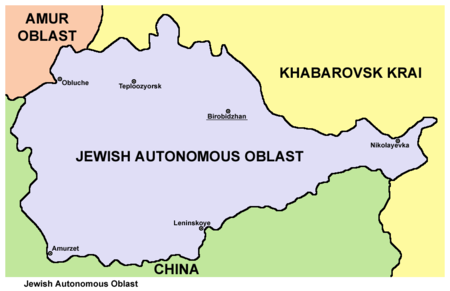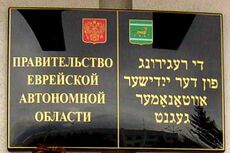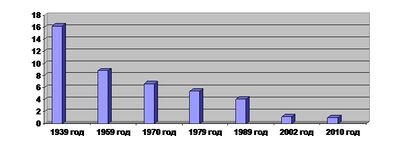الأبلاست الذاتي اليهودي
Jewish Autonomous Oblast | |
|---|---|
| Еврейская автономная область | |
| الترجمة اللفظية بالـ Other | |
| • Yiddish | ייִדישע אװטאָנאָמע געגנט |
 | |
| الإحداثيات: 48°36′N 132°12′E / 48.600°N 132.200°E | |
| البلد | روسيا |
| المنطقة الاتحادية | Far Eastern[1] |
| المنطقة الاقتصادية | Far Eastern[2] |
| تأسست | 7 May 1934[3] |
| Administrative center | Birobidzhan[4] |
| الحكومة | |
| • الكيان | Legislative Assembly[5] |
| • Governor[7] | Rostislav Goldshteyn (acting)[6] |
| المساحة | |
| • Total | 36٬000 كم² (14٬000 ميل²) |
| ترتيب المساحة | 61st |
| التعداد (2010 Census)[9] | |
| • Total | 176٬558 |
| • Estimate (2018) | 162٬014 (−8٫2%) |
| • الترتيب | 80th |
| • الكثافة | 4٫9/km2 (13/sq mi) |
| • Urban | 67٫6% |
| • الريف | 32٫4% |
| منطقة التوقيت | UTC+10 (توقيت فلاديفوستوك |
| ISO 3166 code | RU-YEV |
| لوحات السيارات | 79 |
| OKTMO ID | 99000000 |
| اللغات الرسمية | الروسية;[11] يديشية |
| الموقع الإلكتروني | www.eao.ru |
الأبلاست اليهودي الذاتي ( Jewish Autonomous Oblast (JAO؛ روسية: Евре́йская автоно́мная о́бласть, Yevreyskaya avtonomnaya oblast; باليديشية: ייִדישע אװטאָנאָמע געגנט, yidishe avtonome Gegnt; [jɪdɪʃɛ avtɔnɔmɛ ɡɛɡnt])[12]، يديشية ייִדישע אױטאָנאָמע געגנט، وبالروسية Еврейская автономная область تـُقرأ: إيفريسكايا افتونومايا أوبلاست) وهي إحدى الكيانات الإتحادية في روسيا بمستوى "منطقة إدارية" (о́бласть تـُقرأ: أوبلاست). يحدها من الجنوب الصين الشعبية.
تأسست سنة 1934 بقرار من ستالين. كان الغرض من هذا التأسيس الاعتراف بالاقلية اليهودية كمكون أساسي لروسيا الستالينة حيث كان من حق كل عرق تأسيس وطن قومي. مساحة المنطقة حوالي 36 ألف لم² وعاصمتها بيروبيجان، بينما أكبر مدنها هي اوبلوتشاي. بلغ عدد سكانها عام 2002 حوالي 190 الف نسمة. لغتها الرسمية هي اليدشية إلى جانب الروسية. دستورها المحلي لا يقر بان الديانة الرسمية هي اليهودية.
التاريخ
قبل تأسيس الأوبلاست اليهودي الذاتي
استيلاء روسيا على منطقة الآمور
In 1858 the northern bank of the Amur River, including the territory of today's Jewish Autonomous Oblast, became incorporated into the Russian Empire pursuant to the Treaty of Aigun (1858) and the Convention of Peking (1860).
الاستعمار العسكري
In December 1858 the Russian government authorized the formation of the Amur Cossack Host to protect the south-east boundary of Siberia and communications on the Amur and Ussuri rivers.[13] This military colonization included settlers from Transbaikalia. Between 1858 and 1882 many settlements consisting of wooden houses were founded.[14] It is estimated that as many as 40,000 men from the Russian military moved into the region.[14]
Expeditions of scientists, including geographers, ethnographers, naturalists, and botanists such as Mikhail Ivanovich Venyukov (1832–1901), Leopold von Schrenck, Karl Maximovich, Gustav Radde (1831–1903), and Vladimir Leontyevich Komarov promoted research in the area.[13]
إنشاء سكة حديد سيبيريا
In 1899, construction began on the regional section of the Trans-Siberian Railway connecting Chita and Vladivostok. The project produced a large influx of new settlers and the foundation of new settlements. Between 1908 and 1912 stations opened at Volochayevka, Obluchye, Bira, Birakan, Londoko, In, and Tikhonkaya. The railway construction finished in October 1916 with the opening of the 2،590-متر (8،500 ft) Khabarovsk Bridge across the Amur at Khabarovsk.
During this time, before the 1917 revolutions, most local inhabitants were farmers.[13] The only industrial enterprise was the Tungussky timber mill, although gold was mined in the Sutara River, and there were some small railway workshops.[13]
الحرب الأهلية الروسية
In 1922, during the Russian Civil War, the territory of the future Jewish Autonomous Oblast became the scene of the Battle of Volochayevka.[15]
الاستيطان اليهودي في المنطقة
السياسات السوفيتية فيما يتعلق بالأقليات واليهود
Although Judaism as a religion ran counter to the Bolshevik party's policy of atheism, Vladimir Lenin wanted to appease minority groups to gain their support and provide examples of tolerance.[16]
In 1924, the unemployment rate among Jews exceeded 30%, partially as a result of pogroms[17] but also as a result of the policies of the USSR, which prohibited people from being craftspeople and small businessmen.[18] With the goal of getting Jews back to work to be more productive members of society, the government established Komzet, the committee for the agricultural settlement of Jews.[17] The Soviet government entertained the idea of resettling all Jews in the USSR in a designated territory where they would be able to pursue a lifestyle that was "socialist in content and national in form". The Soviets also wanted to offer an alternative to Zionism, the establishment of Mandate of Palestine as a Jewish homeland. Socialist Zionists such as Ber Borochov were gaining followers at that time and Zionism was a rival ideology to Marxism among left-wing Jews.[13] The location that was initially considered in the early 1920s was Crimea, which already had a significant Jewish population[13] Two Jewish districts (raiony) were formed in Crimea and three in south Ukraine.[17][19] However, an alternative scheme, perceived as more advantageous, was put into practice.[13]
تأسيس الأوبلاست اليهودي الذاتي
Eventually, Birobidzhan, in what is now the JAO, was chosen by the Soviet leadership as the site for the Jewish region.[20] The choice of this area was a surprise to Komzet; the area had been chosen for military and economic reasons.[16] This area was often infiltrated by China, while Japan also wanted Russia to lose the provinces of the Soviet Far East. At the time, there were only about 30,000 inhabitants in the area, mostly descendants of Trans-Baikal Cossacks resettled there by tsarist authorities, Koreans, Kazakhs, and the Tungusic peoples.[21] The Soviet government wanted to increase settlement in the remote Soviet Far East, especially along the vulnerable border with China. General Pavel Sudoplatov writes about the government's rationale behind picking the area in the Far East: "The establishment of the Jewish Autonomous Oblast in Birobidzhan in 1928 was ordered by Stalin only as an effort to strengthen the Far Eastern border region with an outpost, not as a favour to the Jews. The area was constantly penetrated by Chinese and White Russian resistance groups, and the idea was to shield the territory by establishing a settlement whose inhabitants would be hostile to White Russian émigrés, especially the Cossacks. The status of this region was defined shrewdly as an autonomous district, not an autonomous republic, which meant that no local legislature, high court, or government post of ministerial rank was permitted. It was an autonomous area, but a bare frontier, not a political center."[22]
On 28 March 1928, the Presidium of the General Executive Committee of the USSR passed the decree "On the attaching for Komzet of free territory near the Amur River in the Far East for settlement of the working Jews."[23] The decree meant "a possibility of establishment of a Jewish administrative territorial unit on the territory of the called region".[13][23]
The new territory was initially called the Birobidzhan Jewish National Raion.[16]
Birobidzhan had a harsh geography and climate: it was mountainous, covered with virgin forests of oak, pine and cedar, and also swamplands, and any new settlers would have to build their lives from scratch. To make colonization more enticing, the Soviet government allowed private land-ownership. This led to many non-Jews settling in the oblast to get a free farm.[24]
In the spring of 1928, 654 Jews arrived to settle in the area; however, by October 1928, 49.7% of them had left because of the severe conditions.[16] In the summer of 1928, there were torrential rains that flooded the crops and an outbreak of anthrax that killed the cattle.[25]
On 7 May 1934, the Presidium of the General Executive Committee accepted the decree on its transformation into the Jewish Autonomous Region within the Russian Federation.[13] In 1938, with formation of the Khabarovsk Territory, the Jewish Autonomous Region (JAR) was included in its structure.[23]
Attempts to encourage settlement in the JAO
In the 1930s, a Soviet promotional campaign was created to entice more Jewish settlers to move there. The campaign partly incorporated the standard Soviet promotional tools of the era, including posters and Yiddish-language novels describing a socialist utopia there. In one instance, leaflets promoting Birobidzhan were dropped from an airplane over a Jewish neighborhood in Belarus. In another instance, a government-produced Yiddish film called Seekers of Happiness told the story of a Jewish family from the United States making a new life for itself in Birobidzhan.[13]
Growth of Jewish communities in the early 1930s
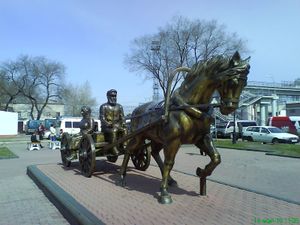
Early Jewish settlements included Valdgeym, dating from 1928, which included the first collective farm established in the oblast,[26] Amurzet, which was the center of Jewish settlement south of Birobidzhan from 1929 to 1939,[27] and Smidovich.
The Organization for Jewish Colonisation in the Soviet Union, a Jewish Communist organization in North America, successfully encouraged the immigration of some US residents, such as the family of the future spy George Koval, which arrived in 1932.[13][28] Some 1,200 non-Soviet Jews chose to settle in Birobidzhan.[13][20]
As the Jewish population grew, so did the impact of Yiddish culture on the region. The settlers established a Yiddish newspaper, the Birobidzhaner Shtern; a theatre troupe was created; and streets being built in the new city were named after prominent Yiddish authors such as Sholom Aleichem and I. L. Peretz.[29]
Stalin era and World War II
The Jewish population of JAO reached a pre-war peak of 20,000 in 1937.[30] According to the 1939 population census, 17,695 Jews lived in the region (16% of the total population).[23][31]
After the war ended in 1945, there was renewed interest in the idea of Birobidzhan as a potential home for Jewish refugees. The Jewish population in the region peaked at around 46,000–50,000 Jews in 1948, around 25% of the entire population of the JAO.[32]
الحرب الباردة
The census of 1959 found that the Jewish population of the JAO had declined by approximately 50%, down to 14,269 persons.[31]
A synagogue was opened at the end of World War II, but it closed in the mid 1960s after a fire left it severely damaged.[33]
In 1980, a Yiddish school was opened in Valdgeym.[34]
According to the 1989 Soviet Census, there were 8,887 Jews living in the JAO, or 4% of the total JAO population of 214,085.[16]
ما بعد انحلال الاتحاد السوفيتي
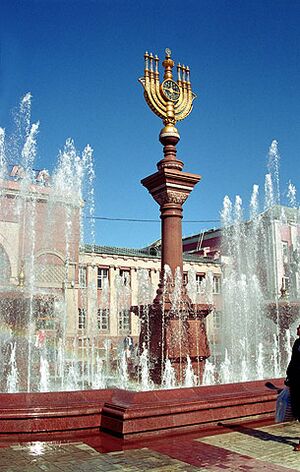
In 1991, after the breakup of the Soviet Union, the Jewish Autonomous Oblast moved from the jurisdiction of Khabarovsk Krai to the jurisdiction of the Russian Federation. However, by that time, most of the Jews had emigrated from the Soviet Union and the remaining Jews constituted fewer than 2% of the local population.[29] In early 1996, 872 people, or 20% of the Jewish population at that time, emigrated to Tel Aviv via chartered flights.[35] As of 2002, 2,357 Jews were living in the JAO.[31] A 2004 article stated that the number of Jews in the region "was now growing".[36] As of 2005, Amurzet had a small active Jewish community.[37] An April 2007 article in The Jerusalem Post claimed that the Jewish population had grown to about 4,000. The article cited Mordechai Scheiner, the Chief Rabbi of the JAO from 2002 to 2011, who said that, at the time the article was published, Jewish culture was enjoying a religious and cultural resurgence.[38] By 2010, according to data provided by the Russian Census Bureau, there were only approximately 1,600 people of Jewish descent remaining in the JAO (1% of the total population), while ethnic Russians made up 93% of the JAO population.[39]
According to an article published in 2000, Birobidzhan has several state-run schools that teach Yiddish, a Yiddish school for religious instruction and a kindergarten. The five- to seven-year-olds spend two lessons a week learning to speak Yiddish, as well as being taught Jewish songs, dance, and traditions.[40] A 2006 article in The Washington Times stated that Yiddish is taught in the schools, a Yiddish radio station is in operation, and the Birobidzhaner Shtern newspaper includes a section in Yiddish.[41]
Geography
Climate
The territory has a monsoonal/anticyclonic climate, with warm, wet, humid summers due to the influence of the East Asian monsoon, and cold, dry, windy conditions prevailing in the winter months courtesy of the Siberian high-pressure system.
Administrative divisions
الاقتصاد
The Jewish Autonomous Oblast is part of the Far Eastern Economic Region; it has well-developed industry and agriculture and a dense transportation network. Its status as a free economic zone increases the opportunities for economic development. The oblast's rich mineral and building and finishing material resources are in great demand on the Russian market. Nonferrous metallurgy, engineering, metalworking, and the building material, forest, woodworking, light, and food industries are the most highly developed industrial sectors.[42]
Agriculture is the Jewish Autonomous Oblast's main economic sector owing to fertile soils and a moist climate.
The largest companies in the region include Kimkano - Sutarsky Mining and Processing Plant (with revenues of $116.55 million in 2017), Teploozersky Cement Plant ($29.14 million) and Brider Trading House ($24 million).[43]
النقل
The region's well-developed transportation network consists of 530 km (330 mi) of railways, including the Trans-Siberian Railway; 600 km (370 mi) of waterways along the Amur and Tunguska rivers; and 1،900 km (1،200 mi) of roads, including 1،600 km (1،000 mi) of paved roads. The most important road is the Khabarovsk-Birobidzhan-Obluchye-Amur Region highway with ferry service across the Amur. The Birobidzhan Yuzhniy Airfield, in the center of the region, connects Birobidzhan with Khabarovsk and outlying district centers.
Tongjiang-Nizhneleninskoye railway bridge
The Tongjiang-Nizhneleninskoye railway bridge is a 19.9 km (12.4 mi) long, $355 million, bridge under construction that will link Nizhneleninskoye in the Jewish Autonomous Oblast with Tongjiang in the Heilongjiang Province of China. The bridge is expected to open in the end of 2021[44] and is expected to transport more than 3 million طن متري (3.3 million short ton; 3.0 million long ton) of cargo and 1.5 million passengers per year.[45]
الديمغرافيا الحالية
The population of JAO has declined by almost 20% since 1989, with the numbers recorded being 215,937 (تعداد 1989)[46] and 176,558 (تعداد 2010);[9] The 2010 Census reported the largest group to be the 160,185 ethnic Russians (93%), followed by 4,871 ethnic Ukrainians (3%), and 1,628 ethnic Jews (1%).[9] Additionally, 3,832 people were registered from administrative databases, and could not declare an ethnicity. It is estimated that the proportion of ethnicities in this group is the same as that of the declared group.[47]
In 2012, there were 2445 births (14.0 per 1000), and 2636 deaths (15.1 per 1000).[48] The total fertility rate has seen an upward trend since 2009, rising from 1.67 to 1.96 children per adult.[49]
اللغات المحكية
Yiddish is taught in three of the region's schools, but the community is almost exclusively Russian-speaking.[50]
الدين
انظر أيضاً
- Beit T'shuva
- East Asian Jews
- Far Eastern Railway (of former Baikal-Amur (BAM) project)
- History of the Jews in the Jewish Autonomous Oblast
- History of the Jews in Russia
- History of the Jews in the Soviet Union
- In Search of Happiness
- Boris "Dov" Kaufman
- List of Chairmen of the Legislative Assembly of the Jewish Autonomous Oblast
- Proposals for a Jewish state
- Slattery Report, a proposal in the US to settle Jewish refugees from Europe in Alaska.
- Yevsektsiya
المراجع
ملاحظات
- ^ Президент Российской Федерации. Указ №849 от 13 мая 2000 г. «О полномочном представителе Президента Российской Федерации в федеральном округе». (President of the Russian Federation. Decree #849 of May 13, 2000 On the Plenipotentiary Representative of the President of the Russian Federation in a Federal District).
- ^ Госстандарт Российской Федерации. №ОК 024-95 27 декабря 1995 г. «Общероссийский классификатор экономических регионов. 2. Экономические районы», в ред. Изменения №5/2001 ОКЭР. (گوستاندارت of the Russian Federation. #OK 024-95 December 27, 1995 Russian Classification of Economic Regions. 2. Economic Regions, as amended by the Amendment #5/2001 OKER).
- ^ Charter of the Jewish Autonomous Oblast, Article 4
- ^ Charter of the Jewish Autonomous Oblast, Article 5
- ^ Charter of the Jewish Autonomous Oblast, Article 15
- ^ Official website of the Jewish Autonomous Oblast. Alexander Borisovich Levintal, Governor of the Jewish Autonomous Oblast (in روسية)
- ^ Charter of the Jewish Autonomous Oblast, Article 22
- ^ Федеральная служба государственной статистики (Federal State Statistics Service) (2004-05-21). "Территория, число районов, населённых пунктов и сельских администраций по субъектам Российской Федерации (Territory, Number of Districts, Inhabited Localities, and Rural Administration by Federal Subjects of the Russian Federation)". Всероссийская перепись населения 2002 года (All-Russia Population Census of 2002) (in الروسية). Federal State Statistics Service. Retrieved 2011-11-01.
- ^ أ ب ت Russian Federal State Statistics Service (2011). "Всероссийская перепись населения 2010 года. Том 1". Всероссийская перепись населения 2010 года (2010 All-Russia Population Census) (in Russian). Federal State Statistics Service. Retrieved June 29, 2012.
{{cite web}}: Invalid|ref=harv(help); Unknown parameter|trans_title=ignored (|trans-title=suggested) (help)CS1 maint: unrecognized language (link) - ^ "Об исчислении времени". Официальный интернет-портал правовой информации (in الروسية). 3 June 2011. Retrieved 19 January 2019.
- ^ الرسمية في جميع أرجاء روسيا الاتحادية حسب الفقرة 68.1 من دستور روسيا.
- ^ In standard Yiddish: ייִדישע אױטאָנאָמע געגנט, Yidishe Oytonome Gegnt
- ^ أ ب ت ث ج ح خ د ذ ر ز س Asya Pereltsvaig (October 9, 2014). "Birobidzhan: Frustrated Dreams of a Jewish Homeland".
- ^ أ ب Ravenstein, Ernst Georg (1861). The Russians on the Amur: its discovery, conquest, and colonization, with a description of the country, its inhabitants, productions, and commercial capabilities ... Trübner and co. p. 156.
- ^ Anniversary of the Battle of Volochayevka
- ^ أ ب ت ث ج "Nation Making in Russia's Jewish Autonomous Oblast" (PDF). Archived from the original (PDF) on September 2, 2016. Retrieved January 13, 2017.
- ^ أ ب ت Kipnis, Mark. "Komzet". Jewish Virtual Library. Encyclopaedia Judaica. Archived from the original on 16 January 2017.
- ^ Masha Gessen (September 7, 2016). "'Sad And Absurd': The U.S.S.R.'s Disastrous Effort To Create A Jewish Homeland". NPR.
- ^ Yaacov Ro'i (2004). Jews and Jewish Life in Russia and the Soviet Union. Frank Cass & Co. p. 193. ISBN 9780714646190.
- ^ أ ب Arthur Rosen (February 2004). "Birobidzhan – the Almost Soviet Jewish Autonomous Region".
- ^ Nora Levin (1990). The Jews in the Soviet Union Since 1917: Paradox of Survival, Volume 1. New York University Press. p. 283. ISBN 9780814750513.
- ^ Pavel Sudoplatov and Anatolii Sudoplatov, with Jerrold L. Schecter and Leona P. Schecter, Special Tasks: The Memoirs of an Unwanted Witness – A Soviet Spymaster, Boston, MA: Little, Brown & Co., 1994, p. 289.
- ^ أ ب ت ث Behind Communism
- ^ Richard Overy (2004). The Dictators: Hitler's Germany, Stalin's Russia. W.W. Norton Company, Inc. p. 567.
- ^ Gessen, Masha (2016). Where the Jews Aren't: The Sad and Absurd Story of Birobidzhan, Russia's Jewish Autonomous Region. ISBN 9780805242461.
- ^ "Stalin's forgotten Zion: the harsh realities of Birobidzhan". Swarthmore.
- ^ "A Jew Receives State Award in Jewish Autonomous Republic". Birobidjan, RU: The Federation of Jewish Communities of the CIS. 31 August 2004. Archived from the original on July 20, 2014. Retrieved 2009-02-18.
{{cite web}}:|archive-date=/|archive-url=timestamp mismatch; سبتمبر 27, 2007 suggested (help)CS1 maint: bot: original URL status unknown (link) - ^ Michael Walsh (May 2009). "George Koval: Atomic Spy Unmasked". Smithsonian.
- ^ أ ب Henry Srebrnik (July 2006). "Birobidzhan: A Remnant of History" (PDF). Jewish Currents.[dead link]
- ^ A History of the Peoples of Siberia: Russia's North Asian Colony 1581–1990
- ^ أ ب ت Russian Political Atlas – Political Situation, Elections, Foreign Policy
- ^ خطأ استشهاد: وسم
<ref>غير صحيح؛ لا نص تم توفيره للمراجع المسماةDavid Holley - ^ Ben G. Frank (April 15, 2012). "A Visit to the 'Soviet Jerusalem'". CrownHeights.info.
- ^ Pinkus, Benjamin (1990). "The Post-Stalin period, 1953–83". The Jews of the Soviet Union: the History of a national minority. Cambridge University Press. p. 272. ISBN 978-0-521-38926-6. Retrieved 2009-02-18.
- ^ James Brook (July 11, 1996). "Birobidzhan Journal;A Promised Land in Siberia? Well, Thanks, but ..." The New York Times.
- ^ Julius Strauss (August 17, 2004). "Jewish enclave created in Siberia by Stalin stages a revival". The Daily Telegraph.
- ^ "Remote Far East Village Mobilizes for Purim". Federation of Jewish Communities of the CIS. March 10, 2005. Archived from the original on February 4, 2009.
{{cite web}}: CS1 maint: bot: original URL status unknown (link) - ^ Haviv Rettig Gur (April 17, 2007). "Yiddish returns to Birobidzhan". The Jerusalem Post.
- ^ "Russia's Jewish Autonomous Region In Siberia 'Ready' To House European Jews". Radio Free Europe. January 20, 2016.
- ^ Steen, Michael (January 13, 2000). "Soviet-era Jewish homeland struggles on". Utusan Online. Archived from the original on January 13, 2017. Retrieved January 12, 2017.
- ^ http://www.washingtontimes.com, The Washington Times (7 January 2006). "Jewish life revived in Russia". The Washington Times.
{{cite news}}: External link in|last1= - ^ "Jewish Autonomous Region". Kommersant Moscow. Kommersant. Publishing House. مارس 5, 2004. Archived from the original on نوفمبر 4, 2011. Retrieved ديسمبر 22, 2011.
- ^ Выписки ЕГРЮЛ и ЕГРИП, проверка контрагентов, ИНН и КПП организаций, реквизиты ИП и ООО. СБИС (in الروسية). Retrieved 20 October 2018.
- ^ "Срок строительства моста из ЕАО в Китай перенесли на осень 2021 года" (in الروسية). ITAR-TASS. 14 February 2020.
- ^ "Work Starts On First China-Russia Highway Bridge". Radio Free Europe. December 25, 2016.
- ^ "Всесоюзная перепись населения 1989 г. Численность наличного населения союзных и автономных республик, автономных областей и округов, краёв, областей, районов, городских поселений и сёл-райцентров.[[Category:Articles containing روسية-language text]] (All Union Population Census of 1989. Present population of union and autonomous republics, autonomous oblasts and okrugs, krais, oblasts, districts, urban settlements, and villages serving as district administrative centers.)". Всесоюзная перепись населения 1989 года (All-Union Population Census of 1989) (in Russian). Demoscope Weekly (website of the Institute of Demographics of the State University—Higher School of Economics. 1989. Retrieved 2007-12-13.
{{cite web}}: Italic or bold markup not allowed in:|publisher=(help); URL–wikilink conflict (help)CS1 maint: unrecognized language (link) - ^ "Перепись-2010: русских становится больше". Perepis-2010.ru. 2011-12-19. Archived from the original on December 25, 2018. Retrieved 2013-04-19.
- ^ "Естественное движение населения в разрезе субъектов Российской Федерации". Gks.ru. Retrieved 2013-04-19.
- ^ The Demographic Yearbook of Russia
- ^ Gal Beckerman (August 31, 2016). "A Promised Land in the U.S.S.R." The New Republic.
- ^ "Arena: Atlas of Religions and Nationalities in Russia". Sreda, 2012.
- ^ 2012 Arena Atlas Religion Maps. "Ogonek", № 34 (5243), 27/08/2012. Retrieved 21/04/2017. Archived.
مصادر
- المقاطعة العبرية ذات الحكم الذاتي روسيا اليوم .
- قالب:RussiaBasicLawRef/yev
للاستزادة
- American Committee for the Settlement of Jews in Birobidjan, Birobidjan: The Jewish Autonomous Territory in the USSR. New York: American Committee for the Settlement of Jews in Birobidjan, 1936.
- Melech Epstein, The Jew and Communism: The Story of Early Communist Victories and Ultimate Defeats in the Jewish Community, USA, 1919–1941. New York: Trade Union Sponsoring Committee, 1959.
- Henry Frankel, The Jews in the Soviet Union and Birobidjan. New York: American Birobidjan Committee, 1946.
- Masha Gessen, Where the Jews Aren’t: The Sad and Absurd Story of Birobidzhan, Russia’s Jewish Autonomous Region, 2016.
- Ber Boris Kotlerman and Shmuel Yavin, Bauhaus in Birobidzhan. Tel Aviv: Bauhaus Center, 2009.
- Nora Levin, The Jews in the Soviet Union Since 1917: Paradox of Survival: Volume 1. New York: New York University Press, 1988.
- James N. Rosenberg, How the Back-to-the-Soil Movement Began: Two Years of Blazing the New Jewish "Covered Wagon" Trail Across the Russian Prairies. Philadelphia: United Jewish Campaign, 1925.
- Anna Shternshis, Soviet and Kosher: Jewish Popular Culture in the Soviet Union, 1923–1939. Bloomington, IN: Indiana University Press, 2006.
- Henry Felix Srebrnik, Dreams of Nationhood: American Jewish Communists and the Soviet Birobidzhan Project, 1924–1951. Boston: Academic Studies Press, 2010.
- Robert Weinberg, Stalin's Forgotten Zion: Birobidzhan and the Making of a Soviet Jewish Homeland: An Illustrated History, 1928–1996. Berkeley, CA: University of California Press, 1998.
وصلات خارجية
- Official website of the Jewish Autonomous Oblast
- Stalin's Forgotten Zion: Birobidzhan and the Making of a Soviet Jewish Homeland: An Illustrated History, 1928–1996
- A 1939 Soviet pamphlet about the JAO
- Meeting of the Frontiers: The Birobidzhan Album (1920s–1930s photographs of Birobidzhan)
- Pages using gadget WikiMiniAtlas
- Articles containing روسية-language text
- Articles with روسية-language sources (ru)
- CS1 الروسية-language sources (ru)
- CS1 errors: unsupported parameter
- Articles containing يديشية-language text
- CS1 errors: archive-url
- CS1 maint: bot: original URL status unknown
- Articles with dead external links from July 2018
- CS1 uses الروسية-language script (ru)
- CS1 errors: markup
- CS1 errors: URL–wikilink conflict
- Short description is different from Wikidata
- Coordinates on Wikidata
- Pages using Lang-xx templates
- Pages with plain IPA
- Articles with hatnote templates targeting a nonexistent page
- Jewish Autonomous Oblast
- 1934 establishments in the Soviet Union
- East Asian Jews
- Far Eastern Federal District
- Jewish polities
- Jews and Judaism in the Soviet Union
- منشوريا
- Proposed Jewish states
- Russian Far East
- Russian-speaking countries and territories
- Settlement schemes
- دول وأقاليم تأسست في 1934
- Yiddish culture in Russia
- روسيا
- الأوبلاست اليهودية الذاتية
- بلدان ومقاطعات ناطقة بالروسية


